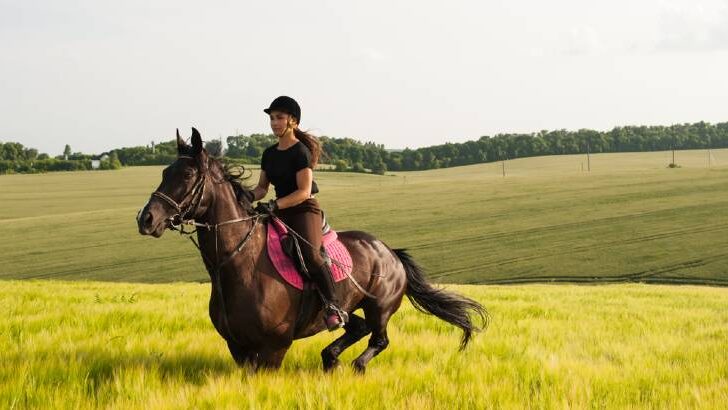Affiliate Disclaimer
As an Amazon Associate I earn from qualifying purchases. It helps me keep the website going. Thank you for your support.
Standing at the fence watching a horse race is an exhilarating experience. You can literally feel the ground shake and the wind change as the horses gallop past. Horses are athletic animals who can turn their hoof to a number of different sports and activities. But how long can a horse run?
Horses can cover distances of up to 40 miles when running for several hours at trot. However, the length of time and distance greatly reduces as speed increases. Horses can achieve speeds of up to 40 or 50 miles per hour, but cannot run at this speed for very long.
There are many other factors that affect how long a horse can run. Read on to learn more about how horses move and how far and fast they can run.
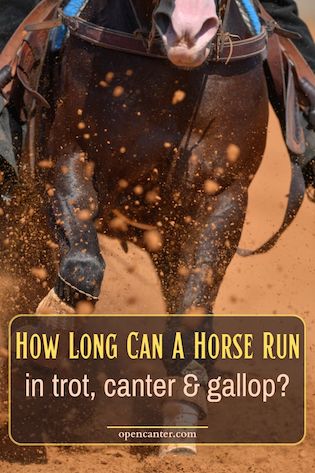
Firstly…a Little About How Horses Move
Horses do not simply walk or run like humans do. They have different ways of moving at different speeds, called gaits. Most horses have four different gaits; walk, trot, canter, and gallop. Each gait has a different sequence of footsteps. Walk is the slowest gait, and gallop is the fastest.
Sometimes there are variations to the normal gaits of the horse. In Western riding, horses perform a slower trot and canter called a jog and a lope. The movement is exactly the same as the horse’s normal gait, but simply slower.
Additionally, the sport of dressage features variations within each gait. For example, a single dressage test may contain collected and extended trot. Both movements are performed at the same gait, the trot. However, the horse takes much shorter steps in the collected trot and longer ones in the extended trot.
Most horse breeds will only have the four standard gaits. However, there are some breeds, known as gaited breeds, that have different or extra gaits. These breeds include the American Saddlebred, Icelandic Horse, Paso Fino, and Tennessee Walking Horse.
How Long Can a Horse Run in Trot?
Trotting is a very efficient gait for the horse, and they can cover long distances in a steady trot. It is a two-beat gait, and the legs move in diagonal pairs. There is a moment of suspension between each pair hitting the ground. Most horses trot at a speed of around eight miles per hour.
The trot is similar to jogging for humans – faster than a walk, but not so fast that it is tiring. Horses can cover anywhere between 20 and 40 miles a day in trot. However, the horse will usually take breaks walking when covering such a large distance.
The trot can also be a much faster gait, and some horse races are done in trot. Horses that are used for these races have been recorded at over 30 miles per hour! However, this speed is not sustainable for a long distance.
Most horses are comfortable in trot. Providing they are fit enough and there are no other impacting factors, horses can trot for hours. However, this should not be a regular occurrence, as horses require times of rest to recover and avoid injury.
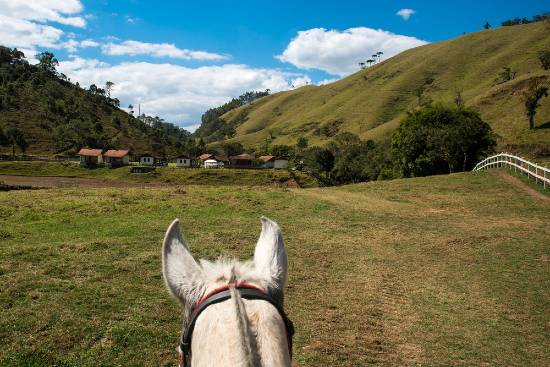
How Long Can a Horse Run in a Canter?
The canter is a faster, three-beat gait, with a moment of suspension. It is also an asymmetrical gait, meaning there is a right and left leading leg. The leading leg is whichever foreleg is the last leg to hit the ground each stride. Horses will often switch leading legs when starting to tire or due to preference.
A steady canter for most horses sits at around 10-17 miles per hour. However, this gait is not as efficient for the horse as trot. Very fit horses can cover around seven to 10 miles before tiring.
The canter is easier for the rider to sit to, and it is likened to sitting on a rocking horse. Most horses enjoy cantering; however, some can get a little too excited. Their canter speeds up and becomes closer to a gallop. This will tire the horse out faster.
Young horses or horses new to being ridden can also struggle with the canter. They might become unbalanced and switch which legs they use to try and keep their balance. These horses won’t be able to cover any considerable distance until they are more balanced.
How Long Can a Horse Run In a Gallop?
Galloping is the fastest gait and is an extension of the canter. If the horse is asked to lengthen its canter stride enough, it will turn into gallop. The two hooves that were hitting the ground in a pair in canter now hit the ground separately.
The gallop is a four-beat gait, with a moment of suspension. Like the canter, it is also asymmetrical, and horses can swap their leading leg when they start to tire.
A well-conditioned and fit horse can reach a speed of up to 40 miles per hour. Quarter horses are known for their speed over short distances, and have reached speeds up to 55 miles per hour! However, this is not sustainable for a distance of more than a mile or two. Horses tire very fast when galloping, especially when they are running as fast as possible.
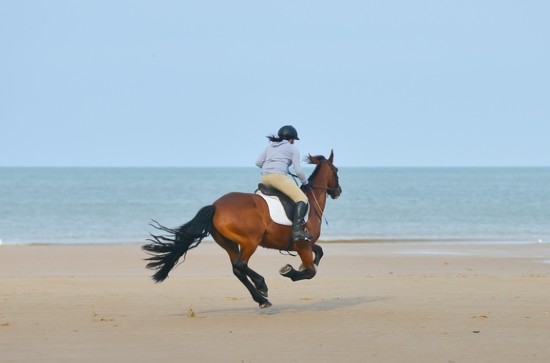
Interestingly, the gallop is the only pace that cannot be collected. The walk, trot, and canter can all be collected so the horse takes shorter steps within the same gait. If the rider tries to collect the gallop, it will turn back into the three-beat canter.
Horses can gallop at different speeds. The hand gallop in the show ring is not as taxing on the horse and can be maintained for longer. This is different from the gallop seen in racehorses, who are being pushed to the limits of their speed.
Why Can Horses Run So Far?
Horses’ endurance and speed stem from their wild ancestors. Horses had to be able to cover long distances to find food and water. As they lived in herds, they had to move around regularly. It would not take long for a herd to eat all the grass in a particular area.
Horses also moved around depending on the seasons. They needed to find shelter in the winter, as well as feed. During hot weather, finding water can become a challenge. This is why horses can cover long distances in walk and trot. You can read more about how far a horse can travel in a day here.
Horses also had to be able to escape predators. This is where the speed of the gallop is required. The horse often did not have to run very far, but had to escape very quickly. Agility was also required, to duck and weave through trees or bushes.
What Things Affect How Long a Horse Can Run?
There are many things that can affect how long a horse can run. The breed, fitness level, age, and history of the horse will all affect their level of endurance.
The breed of horse has a huge impact on how long a horse can run. The horse’s breed will impact what type of muscle fibers the horse has. There are two main types: slow twitch (type I) and fast twitch (type II). All horses have both types, but different breeds will have more of one type than the other.
Slow twitch fibers are more resistant to fatigue. They use energy slower and more evenly, making it last a longer period of time. These kinds of muscle fibers are found in heavier breeds, like the Clydesdale and Warmblood.
Fast twitch fibers are good for providing short and sharp bursts of energy, but they tire quickly. They use lots of energy all at once. These kinds of muscle fibers are found in breeds like Thoroughbreds and Quarter Horses.
Breeds with more fast twitch muscles are better suited for short-term speed, rather than long-distance endurance. Breeds like the Arabian and Standardbred have about 75% fast twitch muscle fibers. This makes them a good choice for endurance racing. They have the muscles required for speed, but with correct conditioning, enough slow twitch fibers to last the distance. (source)
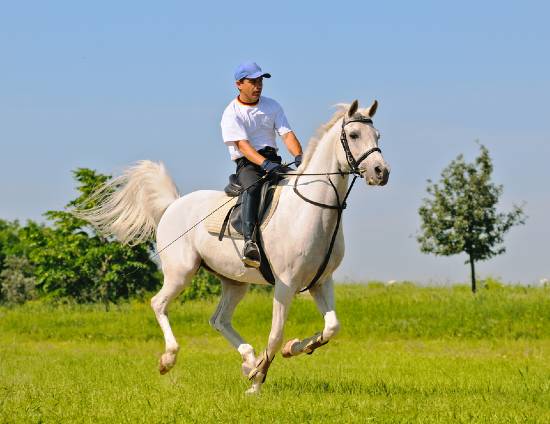
The Impact of Fitness
Fitness level also has a huge impact. An unfit horse cannot cover any great length of distance without tiring, regardless of the breed. The same horse, if conditioned correctly, can cover longer distances.
Age and previous injuries also affect how long a horse can run. Older horses will struggle to develop and maintain their fitness and will slow down as they age. Younger horses have not yet developed the muscles for long-distance running. Injuries, whether recent or from a long time ago, can make normal movement harder.
Can The Rider Affect How Long a Horse Can Run For?
The rider plays a huge part in how long a horse can run for before tiring. Their weight, balance, and the gear they use, all affect the horse.
A heavy rider requires more effort from the horse to carry. They spend more energy supporting the weight of the rider, meaning less is available for speed or endurance.
The rider’s skill level and balance also impact the horse. An unbalanced rider can be like a dead weight on the horse’s back. They can also make the horse sore if they are bouncing around in the saddle or grabbing on the reins. This is different from a well-balanced rider who moves with the horse.
Lastly, the tack and equipment used on the horse must fit correctly. A saddle sitting on the horse’s spine or a breastplate pinching the shoulders will affect how the horse moves. They won’t be able to run as far, for as long, and may act out in pain.
Tack can cause long-term issues and injury if not fitted correctly. It is exactly like wearing shoes that do not fit. At first, the pain was minimal. Over time, you might develop a blister and start to move differently to avoid the pain. Eventually, you might get sore muscles or injure a joint because you now have an obvious limp.
Can I Train My Horse to Run For a Longer Distance?
Yes, you can train your horse to run further! However, this training will only improve the horse within their individual limits. If you do the same training with an Arabian and a Clydesdale, the Arabian will be faster than the Clydesdale. This is because the Arabian has more muscle designed for speed, while the Clydesdale has more muscle designed for slow work.
The key to training your horse to run for a longer distance is slow conditioning. If you suddenly go out and start riding long distances, especially in faster gaits, you can expect injury and tiredness. The horse needs time to build the muscles required to support movement over a long distance.
It is similar to how far humans can run. If you are new to running, you won’t be able to run very far or very fast. However, if you do consistent training, over time you can cover longer distances faster.
A good place to start is to slowly build up the distance at a walk, with short periods of trot. As your horse becomes fitter, you can increase the distance covered at a trot. Over time, you can introduce periods of canter.
During this process, you need to make sure things like tack and rider weight are not negatively impacting the horse. Additionally, the horse must have enough time to rest and recover. Building muscle results in tiny tears in the muscles. As these heal, they result in greater strength and endurance.
If you do not allow enough time to recover, the muscles will become fatigued and you risk much more serious injury. You will also likely have a very unwilling partner because their muscles are sore!
Final Thoughts
The question, ‘How long can a horse run for?’, doesn’t have a straightforward answer. Horses are very athletic animals and can be trained to run fast or cover long distances. However, things like breed, fitness level, age, and rider weight and skill change the answer. Generally, a fit horse can cover a shorter distance quickly at a canter or gallop, or a much longer distance at a walk and trot.

